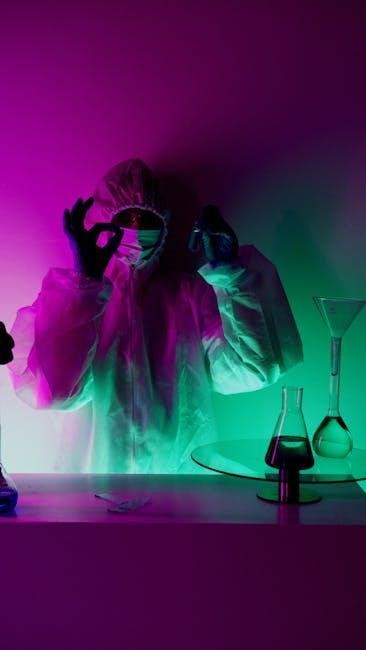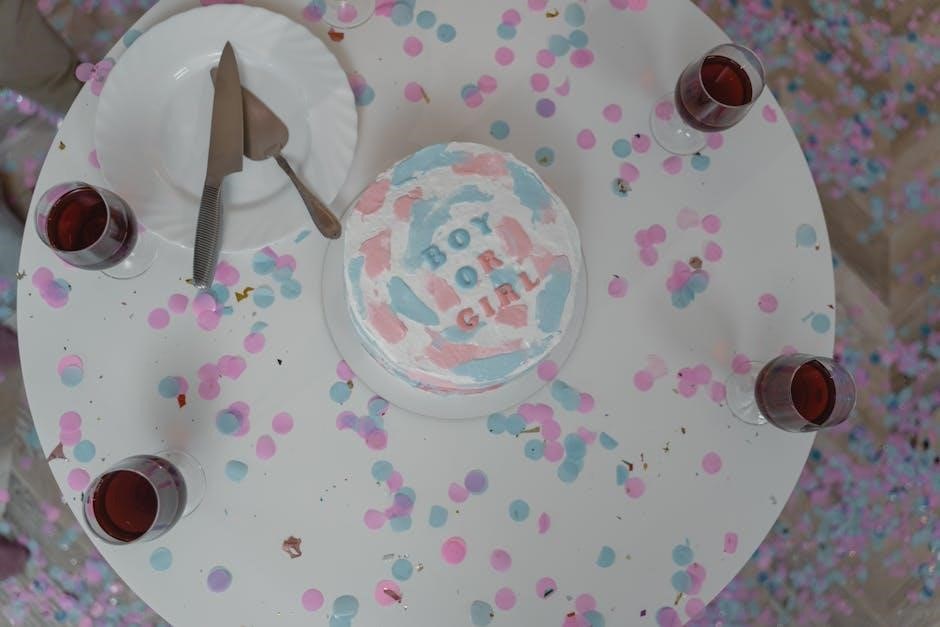
The Colors Personality Test is a popular assessment tool that uses color psychology to identify personality traits․ Based on four primary colors—blue, green, orange, and gold—it helps individuals gain insights into their behavior, preferences, and communication styles․ Widely used for self-awareness, team building, and leadership development, the test offers a unique approach to understanding human personalities through color associations․
Overview of the Colors Personality Test
The Colors Personality Test is a widely recognized tool designed to assess individual personality traits through color associations․ It involves a series of questions where participants circle words that best describe them․ These selections are then tallied on a scoresheet, assigning scores to four primary colors: blue, green, orange, and gold․ Each color represents distinct traits, such as blue for sensitivity and green for analytical thinking․ The test identifies primary and secondary colors, providing insights into behavior, communication styles, and preferences․ It is commonly used for personal growth, team building, and leadership development, offering a simple yet effective way to understand oneself and others․ The test is available in both online and PDF formats, making it accessible for various settings․
Importance of Understanding Personality Through Colors
Understanding personality through colors provides valuable insights into individual traits, behaviors, and communication styles․ This approach helps individuals identify their strengths and weaknesses, fostering self-awareness and personal growth․ By recognizing color personalities, people can improve relationships, enhance teamwork, and adapt their interactions to better connect with others․ In educational and professional settings, this understanding promotes effective communication and collaboration․ It also aids in leadership development by revealing how different personality types approach decision-making and problem-solving․ The practical applications of color personality insights make it a powerful tool for both personal and professional development, enabling individuals to navigate social and workplace dynamics more effectively․

Core Concepts of the Colors Personality Test
The test revolves around four primary colors—blue, green, orange, and gold—each linked to distinct traits․ It assesses personality by identifying dominant and secondary color preferences, shaping behavior and interactions․
The Four Primary Colors and Their Meanings
The Colors Personality Test identifies four primary colors—blue, green, orange, and gold—each representing distinct traits․ Blue symbolizes sensitivity, loyalty, and emotional depth, while green reflects growth, balance, and analytical thinking․ Orange embodies energy, spontaneity, and creativity, and gold represents structure, organization, and a practical approach․ These colors are believed to influence behavior, communication styles, and decision-making processes․ Understanding these meanings helps individuals recognize their dominant traits and how they interact with others․ The test assigns scores to each color, revealing a personality profile that combines primary and secondary colors, offering insights into strengths and areas for personal development․
Blue: Traits and Characteristics
Blue individuals are known for their sensitivity, loyalty, and emotional depth․ They are empathetic and caring, often prioritizing harmony and relationships․ Blues are excellent listeners, making them supportive friends and partners․ Their calm and reflective nature helps them navigate challenging situations thoughtfully․ However, their reserved demeanor can sometimes make them appear distant or overly introspective․ Blues may struggle with opening up to others due to their fear of vulnerability․ Under stress, they may become overwhelmed by their emotions, leading to increased sensitivity․ Despite this, their genuine and compassionate approach to life makes them highly valued in both personal and professional settings․
Green: Traits and Characteristics
Green individuals are analytical, logical, and independent, often excelling in problem-solving and strategic thinking․ They value knowledge and enjoy learning, approaching life with a methodical and organized mindset․ Greens are typically calm and composed, preferring to think before acting․ Their independence can sometimes make them appear detached, but they are deeply reflective and value intellectual connections․ Greens thrive in environments that allow them to analyze and improve processes, making them excellent planners and innovators․ However, their focus on logic may lead them to overlook emotional aspects of situations․ Overall, Greens are growth-oriented, striving to continuously improve themselves and the world around them through their analytical prowess and independent nature․
Orange: Traits and Characteristics
Orange personalities are vibrant, energetic, and sociable, thriving in dynamic environments where they can interact with others; They are naturally optimistic, adaptable, and enjoy taking risks, often seeking new experiences and challenges․ Oranges are action-oriented, valuing freedom and spontaneity, and they excel at thinking on their feet․ Their enthusiasm makes them excellent motivators and team players, but they can sometimes be impulsive or overly focused on immediate gratification․ Oranges prefer collaboration over competition and are known for their ability to mediate conflicts and bring people together․ While they may struggle with patience and long-term commitments, their lively nature and zest for life make them inspiring and engaging individuals․
Gold: Traits and Characteristics
Gold personalities are known for their stability, reliability, and practical nature․ They value structure, organization, and tradition, often excelling in leadership roles due to their strong sense of responsibility․ Gold individuals are detail-oriented, hardworking, and goal-driven, with a focus on achieving excellence in their tasks․ They are typically patient, loyal, and consistent, preferring to plan carefully rather than act impulsively․ Their calm and composed demeanor makes them effective mediators and problem solvers․ However, their adherence to rules and high standards can sometimes make them overly critical or resistant to change․ Overall, Gold personalities are dependable and committed, striving to create order and harmony in their environments․

How the Colors Personality Test Works
The test involves answering questions by circling words that describe you․ A tally sheet scores your responses, determining your primary and secondary color personality type․
Structure of the Test: Questions and Scoring
The Colors Personality Test consists of multiple-choice questions where participants select words or phrases that best describe them․ Each question is linked to one of the four primary colors, and responses are tallied on a scoresheet․ The scoring system assigns points to each color based on the choices made, with higher scores indicating a stronger alignment with that color’s traits․ The test is designed to be straightforward, allowing individuals to quickly identify their primary and secondary color profiles․ This structure ensures a clear and efficient assessment of personality traits, making it accessible for various applications, from personal growth to workplace communication․
Interpreting Test Results: Primary and Secondary Colors
Upon completing the Colors Personality Test, individuals receive a detailed breakdown of their scores for each color—blue, green, orange, and gold․ The color with the highest score is considered the primary color, representing dominant personality traits․ The secondary color, which has the next highest score, influences behavior in specific situations․ Understanding the combination of primary and secondary colors provides a nuanced insight into strengths, weaknesses, and preferences․ This interpretation helps individuals recognize how their personality traits interact and impact relationships, communication, and decision-making․ The results are often used for personal development, team collaboration, and leadership growth, offering a clear framework for self-awareness and improvement․
Understanding the Tally Sheet and Color Scores
The tally sheet is a crucial tool in the Colors Personality Test, used to categorize and score responses based on the four primary colors․ Each question asks participants to select words that best describe them, and these choices are then tallied under the corresponding colors․ The scores are calculated by summing the responses for each color, resulting in a total score that determines the primary and secondary colors․ This process helps individuals identify their dominant traits and how they interact with others․ Understanding the tally sheet and color scores is essential for interpreting test results accurately, providing insights into personality strengths, weaknesses, and preferences․ This structured approach ensures a clear and reliable method for self-assessment and growth․

Applications of the Colors Personality Test
The Colors Personality Test is widely used for personal growth, team building, and education․ It enhances communication, leadership skills, and self-awareness, making it a versatile tool for professional development․
Personal Growth and Self-Awareness
The Colors Personality Test is a powerful tool for fostering personal growth and self-awareness․ By identifying your dominant color, you gain insights into your strengths, weaknesses, and behavioral tendencies․ Understanding your primary and secondary colors helps you recognize patterns in your actions and emotions, enabling you to make positive changes․ This self-awareness can lead to improved decision-making, emotional intelligence, and interpersonal relationships․ The test also encourages reflection on how your color traits influence your goals and aspirations, providing a clear path for personal development․ Ultimately, it empowers individuals to embrace their unique qualities and work on areas for self-improvement, leading to a more fulfilling life․
Team Building and Workplace Communication
The Colors Personality Test is widely used to enhance team building and workplace communication by identifying individual color traits․ Understanding your colleagues’ dominant colors—blue, green, orange, or gold—helps you anticipate their strengths and communication styles․ For instance, blues focus on details and organization, greens thrive on strategy, oranges excel in creativity, and golds prioritize execution․ This awareness fosters collaboration, reduces conflicts, and improves teamwork․ By recognizing these traits, teams can delegate tasks effectively, leverage diverse perspectives, and create a harmonious work environment․ The test also provides insights into how to tailor communication approaches to suit different personality types, ensuring clearer and more productive interactions in the workplace․
Education and Learning Styles
The Colors Personality Test offers valuable insights into education and learning styles by linking personality traits to color preferences․ Educators can use this tool to identify how students prefer to learn—whether through structured, analytical, creative, or practical approaches․ For instance, blue learners may thrive in organized, detail-oriented environments, while orange learners might excel in dynamic, hands-on settings․ Green learners often favor logical, analytical tasks, and gold learners may prefer clear, goal-oriented instructions․ By understanding these color-based preferences, teachers can tailor their teaching methods to meet diverse learning needs, enhancing engagement and academic success․ This personalized approach fosters a more inclusive and effective learning environment for students of all personality types․
Leadership Development and Decision-Making
The Colors Personality Test is a powerful tool for leadership development and decision-making․ By identifying primary and secondary colors, individuals can understand their natural leadership styles and strengths․ For example, gold leaders often excel in structured, goal-oriented environments, while blue leaders thrive in empathetic, collaborative settings․ Green leaders tend to be strategic and analytical, whereas orange leaders are innovative and action-oriented․ This insight helps leaders make informed decisions, delegate tasks effectively, and build stronger team dynamics․ The test also highlights areas for growth, enabling leaders to adapt their approaches and foster a more inclusive and productive work environment․ It’s a valuable resource for both personal and professional development․

Different Versions of the Colors Personality Test
Various versions include the True Colors system and the Color Code test․ These assessments categorize personalities into primary colors, offering insights into traits and behaviors․ They are widely used for personal and professional growth, enhancing self-awareness and team dynamics․ Each version provides unique approaches to understanding individual strengths and weaknesses, promoting effective communication and collaboration․ These tools are popular in education, workplace settings, and personal development, helping users identify their core colors and secondary influences․ They offer practical applications for improving relationships and leadership skills, making them versatile resources for diverse audiences․
True Colors Personality System
The True Colors Personality System, developed by Don Lowry, categorizes personalities into four primary colors: Blue, Green, Orange, and Gold․ Each color represents distinct traits, with Blue symbolizing empathy, Green for analytical thinking, Orange for creativity, and Gold for organization․ This system simplifies complex personality assessments by using color associations to identify dominant and secondary traits․ Widely used in education and workplace settings, True Colors helps improve communication, teamwork, and leadership․ It offers practical tools for self-awareness, enabling individuals to understand their strengths and weaknesses․ The system is adaptable, making it a popular choice for personal and professional development, fostering better relationships and collaboration․
The Color Code Personality Test
The Color Code Personality Test, developed by Taylor Hartman, is a widely recognized tool for understanding personality traits through color associations․ Based on his book, The Color Code, this test categorizes individuals into four primary colors: Red, Blue, White, and Yellow․ Each color represents distinct personality traits, with Red symbolizing confidence, Blue for loyalty, White for peace-seeking, and Yellow for optimism․ The test helps identify strengths, weaknesses, and motivations, providing insights into personal and professional relationships․ It is often used for self-awareness, leadership development, and team building, offering practical strategies for effective communication and collaboration․ The Color Code is valued for its simplicity and depth in personality assessment․
Other Variations and Adaptations
Beyond the True Colors and Color Code systems, other variations of the colors personality test exist, offering unique perspectives․ The Hartman Personality Profile, adapted from Taylor Hartman’s work, uses colors to describe core traits․ Additionally, tests like the Lipstick Color Personality Quiz link color preferences to personality insights․ Some versions, such as the Korean-based K-test, use vibrant, modern designs to appeal to younger audiences․ These adaptations often blend traditional color psychology with contemporary trends, making the tests more engaging․ They cater to diverse needs, from fun social media quizzes to professional development tools, ensuring the colors personality test remains versatile and widely applicable across cultures and contexts․

Science Behind the Colors Personality Test
The test is rooted in color psychology, linking hues to emotional and behavioral traits․ Developed by experts like Don Lowry, it uses research-backed associations to analyze personalities effectively․
Color Psychology and Its Role in Personality Assessment
Color psychology explores how hues influence human emotions and behavior, forming the basis of the Colors Personality Test․ Each color—blue, green, orange, and gold—represents distinct traits․ Blue signifies calmness and trust, green embodies growth and balance, orange reflects energy and enthusiasm, while gold symbolizes stability and leadership․ By associating colors with these traits, the test provides insights into an individual’s personality, helping identify strengths, weaknesses, and communication styles․ This approach leverages the subconscious impact of colors on human perception, offering a unique method for self-discovery and interpersonal understanding․ The test’s effectiveness lies in its ability to simplify complex personality aspects through color associations․
Research Supporting the Use of Colors in Personality Testing
Research supports the use of colors in personality testing, revealing correlations between color preferences and personality traits․ Studies show that specific hues evoke consistent emotional and psychological responses, aligning with distinct personality types․ For instance, blue is often linked to trust and calmness, while orange reflects energy and enthusiasm․ These associations are rooted in color psychology, which has been explored in various studies․ The development of tests like the True Colors Personality System and The Color Code by Taylor Hartman further validates this approach, providing empirical evidence for the role of colors in assessing personality․ Such research underscores the effectiveness of color-based assessments in understanding human behavior and preferences․
Criticisms and Limitations of the Test
The Colors Personality Test has faced criticism for its lack of scientific rigor and empirical support․ Critics argue that the test oversimplifies personality by categorizing individuals into just four colors, neglecting the complexity of human behavior․ Some researchers question the validity of color psychology as a basis for personality assessment, pointing out that color preferences can be influenced by cultural and environmental factors․ Additionally, the test’s subjective nature may lead to inconsistent results, as participants’ interpretations of colors can vary widely․ While the test is popular for its accessibility, it is not universally accepted as a precise or reliable tool for deep psychological insights․

How to Take the Colors Personality Test
To take the Colors Personality Test, circle words describing you, use a tally sheet to score, and identify your primary color for insights․
Step-by-Step Guide to Completing the Test
The Colors Personality Test begins with a series of questions where you circle words or phrases that best describe you․ Each question corresponds to a color․ After completing the test, transfer your selections to a tally sheet to score your responses for each color—blue, green, orange, or gold․ Add up the points for each color to determine your primary and secondary colors․ Review the results to understand your dominant traits and how they influence your behavior․ This structured approach ensures accurate and meaningful insights into your personality and preferences, helping you apply the results to personal or professional growth․
Using the Tally Sheet for Accurate Results
Using the tally sheet for the Colors Personality Test involves systematically recording your responses to ensure accurate results․ Each question in the test is associated with a specific color: blue, green, orange, or gold․ After circling the words that best describe you, locate the corresponding color section on the tally sheet and mark it for each selection․ Once all questions are answered, count the marks for each color․ The color with the most marks is your primary color, representing dominant traits, while the color with the second-most marks is your secondary color․ In case of a tie, both colors may influence your personality equally․ Ensure careful tallying to avoid errors, as accurate counts are crucial for interpreting your results effectively․
Online vs․ PDF Versions: Which is More Effective?
Both online and PDF versions of the Colors Personality Test offer unique advantages․ Online versions provide instant results and automated scoring, making the process quick and efficient․ They often include interactive features and immediate feedback, enhancing user engagement․ PDF versions, however, allow for offline use and manual scoring, which can be beneficial for group activities or workshops․ Some users prefer the tactile experience of marking answers on paper, while others value the convenience of digital platforms․ The choice depends on personal preference and context, as both formats effectively assess personality traits․ For accuracy, ensure proper tallying in PDFs, while online tools handle calculations automatically․

Interpreting and Understanding Test Results
Understanding your color scores reveals insights into your personality traits, strengths, and weaknesses․ Primary and secondary colors indicate dominant and supportive tendencies, guiding personal and professional growth effectively․
Understanding Your Primary and Secondary Colors
Understanding your primary and secondary colors is key to interpreting your personality test results․ Your primary color represents your dominant traits, while your secondary color highlights supportive tendencies․ The tally sheet helps identify these by scoring each color’s frequency in your responses․ Reflect on how your primary color aligns with your behavior and relationships, and consider how your secondary color influences your actions in specific situations; This analysis provides a deeper understanding of your strengths and weaknesses, enabling personal growth and improved communication with others․ By recognizing these color dynamics, you can leverage your personality traits to enhance both personal and professional interactions effectively․
How Colors Influence Behavior and Relationships
Colors significantly influence behavior and relationships by reflecting core personality traits․ For instance, blue individuals are often empathetic and loyal, fostering trust in relationships, while green personalities are analytical and balanced, promoting stability․ Gold types are structured and reliable, ensuring accountability, and orange individuals are spontaneous and energetic, encouraging adaptability․ These color traits shape communication styles, conflict resolution, and emotional responses․ Understanding your color and others’ helps navigate interactions more effectively, fostering harmony and collaboration․ Recognizing these influences allows individuals to leverage their strengths and address weaknesses, leading to more meaningful and productive personal and professional relationships․
Using Test Results for Personal and Professional Development
The results of the Colors Personality Test provide valuable insights for personal and professional growth․ By understanding your primary and secondary colors, you can identify strengths, weaknesses, and communication styles․ This self-awareness enables better decision-making, emotional intelligence, and relationship management․ Professionally, it enhances teamwork, leadership, and conflict resolution․ For example, blue personalities can focus on empathy in collaborations, while gold types can leverage their organizational skills․ The test also aids in career development by aligning roles with natural tendencies․ Overall, the test results serve as a practical tool for self-improvement, fostering a more balanced and effective personal and professional life․

Practical Uses of the Colors Personality Test
The test enhances communication, teamwork, and conflict resolution by identifying personality traits․ It aids in personal growth, education, and leadership development, making it versatile for various professional and personal contexts․
Improving Communication Skills
The Colors Personality Test enhances communication by identifying personal traits and preferences․ By understanding your color type, you can adapt your communication style to resonate with others․ For instance, blue individuals may prioritize empathy, while gold personalities focus on clarity․ This understanding fosters effective interactions and reduces misunderstandings․ The test also provides insights into how different colors perceive information, helping individuals tailor their messages․ Improved communication skills lead to stronger relationships, both personally and professionally․ Utilizing color insights, individuals can navigate conversations with greater empathy and efficiency, ensuring their messages are received as intended․
Enhancing Team Collaboration
The Colors Personality Test is a valuable tool for improving team collaboration by revealing individual strengths and work styles․ By understanding each team member’s color type, teams can assign tasks that align with their natural tendencies, enhancing productivity․ For example, blue personalities often excel at organizing, while orange types may thrive in creative brainstorming․ Green individuals tend to be analytical, and gold personalities are typically strong leaders․ Recognizing these traits fosters mutual respect and reduces conflicts․ The test also encourages open communication about differences, helping teams leverage diversity to achieve shared goals․ This color-based approach creates a cohesive and effective team environment․
Identifying Strengths and Weaknesses
The Colors Personality Test is an effective tool for identifying individual strengths and weaknesses by associating personality traits with specific colors․ For instance, blue personalities are often sensitive and empathetic, making them strong in interpersonal relationships, while green individuals excel in analytical thinking․ Orange types are typically energetic and creative, thriving in dynamic environments, and gold personalities are organized and responsible, excelling in leadership roles․ However, these traits can also reveal weaknesses, such as blue’s tendency to be overly sensitive or gold’s rigidity․ By understanding these aspects, individuals can leverage their strengths and work on improving their weaknesses, fostering personal and professional growth․
Developing Leadership Skills
The Colors Personality Test provides valuable insights for developing leadership skills by aligning personality traits with leadership styles․ Gold personalities, known for their organization and responsibility, often excel as structured leaders, ensuring tasks are completed efficiently․ Blue leaders foster trust and empathy, creating a supportive environment, while green individuals leverage their analytical skills to guide strategic decisions․ Orange personalities, with their creativity and enthusiasm, inspire innovation and adaptability․ By understanding their primary and secondary colors, individuals can identify their leadership strengths and areas for improvement, enabling them to adopt a more balanced and effective approach to guiding teams and achieving organizational goals․
The Colors Personality Test offers a unique, engaging way to explore personality traits, fostering self-awareness and personal growth․ Its simplicity and insights make it a valuable tool for understanding oneself and others, encouraging further exploration of color psychology for enhanced development․
The Impact of the Colors Personality Test on Self-Understanding
The Colors Personality Test significantly enhances self-understanding by linking personality traits to specific colors, providing clear insights into strengths and weaknesses․ It helps individuals recognize their primary and secondary colors, fostering personal growth and self-awareness․ By identifying dominant traits, participants can better navigate relationships, improve communication, and make informed decisions․ This test also encourages reflection on behavior patterns, enabling individuals to align their actions with their core values․ Overall, it serves as a powerful tool for introspection, empowering users to embrace their unique qualities and strive for personal development․
Future Trends in Personality Testing
Future trends in personality testing, including the Colors Personality Test, are expected to focus on digital advancements and personalized insights․ Online versions will likely dominate, offering real-time results and interactive feedback․ AI integration may enhance test accuracy by analyzing behavioral data․ Mobile accessibility will make the test more convenient, reaching a broader audience․ Additionally, there may be more emphasis on dynamic assessments that adapt to individual responses․ The integration of color psychology with other personality frameworks could provide a more holistic understanding․ These advancements aim to make personality testing more engaging, accessible, and effective for personal and professional development․
Encouragement to Explore and Learn More

Exploring the Colors Personality Test can be a transformative journey of self-discovery and growth․ By understanding your primary and secondary colors, you can gain insights into your strengths, weaknesses, and communication styles․ Encourage yourself to delve deeper by revisiting the test periodically to observe changes in your personality spectrum․ Sharing your results with friends, family, or colleagues can foster empathy and improve relationships․ Additionally, integrating color psychology into daily life can enhance decision-making and goal-setting․ Embrace this tool as a stepping stone toward personal and professional development, and inspire others to do the same for a more colorful and harmonious world․